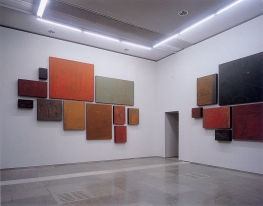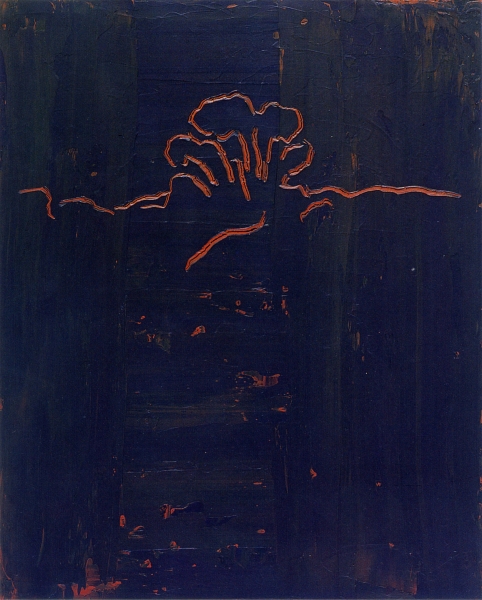
Pedro Calapez - Memória Involuntária
© DGPC/MNAC
2nd Floor
entry: General ConditionsMemória Involuntária
Pedro Calapez
1996-11-21
1997-02-23
Curatorship: Raquel Henriques da Silva
Love of landscape
Following the work evolved around the re-creation of existing architectural works and landscapes, Pedro Calapcz accepted this project, a challenge to directly confront a specific set of landscapes by a late-Naturalist painter. A series of eleven drawings in pastel by Sousa Pinto, dating from 1910 to 1938, which are a visual register suited to this artistic movement and the representation and identification of the places depicted. In simple terms, Calapez has based his adaptation of these drawings on three distinct periods, all marked by the mental process of seeing and (re-seeing) the landscape - the copy, the derivative and the staging of a new rule.
The work began with an apparently academic disposition. Similar to the school attitude of subordination to the master, Pedro Calapez studied each of these works and developed, by a copying principle, an extensive series of drawings, not here on display. Here it is possible to detect, the first signs of ambiguity in the gaze which, in this lengthy succession of experiments, organized the initial stages of a choice, enabling him to see what interested him in these landscapes which, were transformed, in his eyes, by a wide variety of solutions and perspectives. It is by this repetitive gesture of the hand that the artist is going to retain the recollection, the memory, and diverts it in other directions. The craftsmanship part, the "making by hand", is a conceptual process of deliberate capturing of images.
From here he started the second phase in which he excluded direct visual resource to either of the two previous references and started the work to be exhibited. In this phase of semi-obscurity, only the constructed recollections, reflect the images that best correspond to his outline. As if the pathway to this recollection were only be illuminated by the capacity for plastic resolution of his knowledge.
That which might be called the derived pathways, which correspond to the work of "reconstitution" of the landscapes by Sousa Pinto are, in the final analysis, the pathways
which enable Calapez to clarify his way of seeing. The point of departure for the new exercise of seeing, seems more important than recording complicity with the model, or the hypothetical system of equivalencies at the respective points of arrival.
Pedro Calapez does not intend a direct and provocative intervention, nor does he wish to create instability or deconstruction. He is involved in a slow, fractioned activity, in which time is the leading player. It is in the passing of this time that he, at one and the same time, allows recollection and forgetfulness to interact, until the selected outlines are defined. It is also in this phase designated by the artist as "involuntary memory", that the confrontation between the two periods of history is accepted (along with the difficulty of confronting the late, academic solutions of the naturalist painter), and venturing to create a new concept of landscape.
In the continuity of this work process, Calapez has settled on the field of vision in the descriptive landscapes of Sousa Pinto, constructing timeless and indeterminate spaces. In this extensive series of canvases, of varied sizes and thickness, freely developed and demultiplied, naturally, all narrative or fictional elements are absent.
Some suggestions of domestic architecture are used, small courtyards or vegetable gardens, broken lines of streets or houses and are redirected in successive versions, to create a total transformation of scale and meaning. We confront vague architectural spaces and nature divided into portions, which do not contain animal or human presence.
The artist erases the identity of the spaces that Sousa Pinto, with notable freedom of composition, tried to represent and characterize. It is fairly easily to recognize some of these allusions, which serve recollection and choice as to the way of seeing. They are almost always aspects of the landscape which best create exercises in escape or derivation. Calapez frequently lingers over the small twigs which distract from the matrix of the trees, on the sloping branches, in the shallow, ups and clowns, the irregular pathways, water courses which divide, the pathways of uncertainty.
There is a dear inversion of landscape values, between the work of Sousa Pinto and that of Pedro Calapez. The naturalist painter takes the landscape as a whole, as the component parts are organized in relation to recognition and designated unity. He seeks out a landscape inhabited by linked and stable meanings, constructs a live and coherent eptity. Calapez acts in the sense of eliminating any expression of reality. Choosing the fragment, developing imaginary spaces in which the labyrinthical outlines of these uneven forms that, in the end, define the scenario of his visual thought, in the minimum register of meaning, that the development of his work reveals.
The way in which he does this clearly reinforces these values. The set of works exhibited presents a defined overlapping and linking of two distinct planes. On the material and undefined base of an intense chromatic surface, the artist has stressed more explicit lines of colour, which suggest the evasive contour of forms and objects. If these signs enable us to identify elements which refer to the landscapes by Sousa Pinto, thus inscribed, they intensify and materialize forms of transparency and irreality. They make the dense but luminous backgrounds vibrate and configure, at the same time as they expand their absence of content and material impossibility.
The staging of the work contradicts this apparent disorder and unexpectedness. Clearly demonstrating the need to reconstitute order.
Calapcz begins with an historic period and a unit of specific size. Starting from the set of eleven drawings by Sousa Pinto, the artist creates four blocks, made up (also) of eleven pieces of approximate dimensions. The works which integrate each of these blocks present four different densities. The organization of erecting each one of the four walls of the space for the installation obeys a rigorously visual logic, with the canvases grouped and overlapping in variable dimensions and densities. In this way the ordering of the assemblage develops and makes the numerical principle expressed, even more complex, at the same time as it alludes its historic period, in the simulation of an assemblage with nineteenth century nuances. The rules are thus established, as a medium for a new landscape order.
The spatial solutions adopted for mounting the work of the two artists, accentuates the theatrical allusion, that has been visible in the more recent productions by Pedro Calapez. Evoking in a determinant manner the physical presence of the observer who, on entering the space for the installation, where the artist's canvases are isolated, is closed in a cloistered box of vivid colour and complete visual effectiveness. It is possible to decipher the forms and details, which refer to the landscapes by Sousa Pinto, placed outside in the open gallery of the museum.
The sense of spectacle is evident, and the visitor, if following this interpretation, may be enchanted by a most ingenious web of illusions and suggestions. Pedro Calapez, always stimulated by the meeting of different historical periods, has expressed, with this collection of detours and absences, desire for another existence. For each image of the world, the artist has constructed its double and has dared to create new representative concepts.
Along with the most direct, ideological and pragmatic solutions, he has reinitiated, at the turn of the mid-nineties, a way of looking at landscape, in which the models constructed and alluded to convey feelings of nostalgia and of loss, for Nature in decline.
Maria Helena de Freitas
On Exhibition
Mily Possoz. A poetics of space
2025-10-01
2026-02-01
Curatorship: Emília Ferreira
The exhibition “Mily Possoz. A Poetics of Space” continues the research into the lesser-studied Portuguese modernists artists present in the collections of the MNAC and Millennium bcp.
Impressões Digitais. MNAC Collection
2024-12-12
2026-12-30
Curatorship: Ana Guimarães, Emília Ferreira, Maria de Aires Silveira e Tiago Beirão Veiga
Consisting of founding works of contemporary Portuguese art historiography, from 1850 to the present day, the MNAC's collection holds several national treasures.
Since 1911
2022-05-26
2026-05-26
An intervention that celebrates 110 years of the MNAC.











